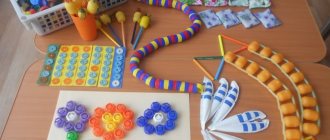Games and exercises for the development of components of the intonation side of speech
And the pots - boom, bang!
Frying pans - don, don!
That's how the dance is - beauty!
Tra-ta-ta, tra-ta-ta!
Games-exercises for the development of tempo organization of statements:
Big feet walked along the road"
Goal: to develop in children the ability to change the tempo of speech in accordance with the tempo of the movement being performed.
Description: According to the speech therapist:
“Big feet walked along the road...”
Children slowly walk in place, raising their legs high and slowly say:
“TOP - TOP.”
Under the words:
"Little feet ran along the path"
children run in place in small steps and quickly say:
“Top - top - top - top.”
Guidelines. In the future, the exercise can be performed to music.
Repeat 3 – 4 times.
"Watch".
Goal: to develop in children the ability to change the tempo of speech in accordance with the tempo of the movement being performed.
Description: Say at different tempos.
Tick tock, tick tock. The clock is big and goes like this.
(They clap and speak slowly.)
Tiki-taki, tiki-taki - The little ones run like that.
(Clap and speak quickly.)
Repeat 3 – 4 times.
"Carousels"
Goal: to develop in children the ability to coordinate speech with movement, gradually changing their tempo.
Description of the game: Children, holding hands, lead a round dance and pronounce words at a slow pace, then start running and pronounce the continuation at a fast pace.
“Barely, barely, barely, barely, the carousel started spinning
(speak at a slow pace)
And then, then, then
(tempo gradually increases)
Everybody run, run, run.
(speak at a fast pace)
Hush, children, don't rush
(tempo gradually slows down)
Stop the carousel
(speak at a slow pace)
One, two, one, two -
(clap your hands and speak slowly)
So the game is over.
Guidelines. The exercise can be performed to music.
Dosage: 2 – 3 times.
"Rain"
Goal: to develop in children the ability to coordinate speech with movement, gradually accelerating their pace.
Game description: Children slowly walk one after another in a circle and slowly say the words:
Drop one, drop two,
The drops barely fall.
Then the pace of movement and speech increases:
And then, then, then-
Everybody run, run, run
.(children run in a circle).
When the words end, the children stop.
We opened our umbrellas
(spread your arms to the sides and join them in a semicircle above your head.)
Sheltered herself from the rain.
Guidelines. The exercise can be performed to music.
Dosage: 3-4 times.
Games and exercises to develop the expressive side of speech
Goal: alternately highlighting words with intonation at the beginning, middle and end of a sentence.
Description: reading tongue twisters should begin at a slow pace, while clearly pronouncing each word. Gradually speed up the pace, but make sure that the child maintains clarity, clarity of pronunciation and maintains the necessary intonation.
Methodological development “Exercises aimed at developing children’s voice formation.”
The set of exercises should include articulatory gymnastics (this is biting the tip of the tongue with the teeth, various biting the tongue with the right and left molars, resting the tip of the tongue on the right or left cheeks, rotating the tongue, lips, flicking the tongue, biting the lips, etc. .).
Sluggish articulation is usually the cause of poor diction; vowels and consonants do not have the necessary clarity, clarity and stability; the sound takes on a monotonous, lifeless character. Of particular importance for the quality of vocal vowels is the activity of not only the anterior part of the articulatory apparatus, but also its posterior part - the pharynx, directly connected to the larynx (activity of the soft palate).
One of the principles of the set of exercises we use is the principle of self-regulation of the voice-forming system: creating conditions for natural automation through precise actions of the controlled part of the vocal apparatus, using some phenomena of voice formation as triggers for singing self-regulation.
Intonation and phonetic exercises.
1. The speech or singing process begins with the attack of a vowel or the pronouncing of a consonant. For this purpose, you can use one of the techniques: a sequence or a simultaneous combination (combination) of pronunciation of sounds. Particular attention is paid to articulation. Inhalation is made silently, the mouth is open as much as possible. To sing the vowel sound A with this position is helped by its combination with the consonant with which it begins: A, AH, HA; let's laugh: HA-HA-HA, HO-HO-HO.
The pronunciation of consonant sounds is active, in a certain sequence. Each sound is pronounced four times. For example, the peculiarities of the pronunciation of the sounds “P” and “B”: they are pronounced with lips elongated like a tube, as if you need to pronounce the syllables “PUH”, “BUH” in a whisper.
2. Replacing the singing or speech attack of a vowel by introducing an additional mode of operation of the larynx-register, located above or below the desired one (for example, a glissando with the voice down, as if something is falling). The main element of the exercise is sliding (gliding) ascending and descending intonation with a sharp transition from chest to falsetto and vice versa with a characteristic “break” of the voice. The so-called question-answer exercise.
3. Make a sound while inhaling. Goal: search for the mode of operation of the larynx. For example, we are surprised.
The larynx of any person or child is capable of producing sounds of a different nature.:
- Noisy sound, not fixed in pitch, low timbre. It can be defined in words as rumble, crackling, rustling, creaking (stroke-bass-register). This sound is produced by the edges of the vocal folds when they are completely relaxed (important!). This sound is similar to the sound that vibrating lips make when passing a strong stream of air through them (without a voice) or the sound “R” pronounced in a whisper, i.e. also without a voice. Stro-bass is a kind of guttural vibrant. With some training and careful auditory control, you can learn to fix the stro-bass in height. This helps to expand the range of the voice when we pronounce with different sounds: we sing five steps up and down, rising in semitones by third, etc.
What are the differences between voice development in childhood and in adulthood?
Each singer has his own level of placement of the larynx, its size is also unique for each organism.. A child’s voice is characterized by a high sound, softness, a smaller range than an adult’s, and iridescence of timbre. There are several stages of its development: 7-9 years - junior pre-mutation age, 10-13 years - senior pre-mutation age, 13-15 years - mutation, 16-18 years - formation of the voice of an adult.
With age, women's voices become lower and rougher, while men's voices become weaker and higher. Throughout a person's life, the vocal cords are influenced by endocrine glands.
In the process of singing, the voice actively develops. Scientists have proven that vocal performance has a positive effect on the emotional sphere and mental development. Performers try to maintain their posture at all times and discipline themselves through regular training.
It is important not to give up on classes, and if it becomes difficult to force yourself, you should contact a tutor. You can find a good vocal teacher on Buki in just a couple of minutes. You can also study online, the main thing is to do your homework.
To make your voice pleasant
The following exercises will make your voice more harmonious.
Three smiles
This exercise is performed in the same way as the previous one, but observing the rule of three smiles. Smile with your mouth, forehead and imagine a smile in the solar plexus area. After this, begin to exhale with sound. Just 5 minutes a day - and your voice will begin to sound more pleasant and trusting.
Yoga exercise
This training is practiced by Indian yogis to achieve a deep and beautiful voice.
Position: standing, feet shoulder-width apart. First, take a few calm breaths and exhalations, then take a deep breath and exhale sharply with the sound “ha-a.” The exhalation should be as full and loud as possible. In this case, the body can be slightly moved forward.
Long syllables
Take a deep breath, and as you exhale, say protractedly “bom-m”, “bim-m”, “bon-n”. Draw out the last sounds as long as possible. Ideally, vibration should occur in the area of the upper lip and nose.
A similar exercise can be done with the syllables “mo-mo”, “mi-mi”, “mu-mu”, “me-me”. But in this case, first pronounce them briefly, and only then protractedly.
Both exercises are best done every morning for 10 minutes. They will not only make your voice more pleasant, but will also help strengthen your vocal cords.
Long tongue
Stick out your tongue. First, point it down as far as possible, trying to reach your chin. Maintaining this position, tilt your head down. Then stretch your tongue upward, trying to reach the tip of your nose. At the same time, raise your head as high as possible.
To make your voice stronger
These exercises will give your voice strength and energy. You will begin to sound louder and more powerful.
Sounds “i”, “e”, “a”, “o”, “u”
Exhale, then take a deep breath and on the second exhale say a long “i” sound. Do this freely as long as you have enough air. Do not force the air out of your lungs. Pronounce the remaining sounds in the same way: “e”, “a”, “o”, “u”. Perform three repetitions.
The sequence of these sounds is not random: they are distributed in height. Accordingly, “i” is the highest (activates the upper area of the head), “u” is the lowest (activates the lower abdomen). If you want to make your voice lower and deeper, practice the “u” sound more often.
Tarzan Exercise
Complete the previous task, only now beat yourself in the chest with your fists, like Tarzan. The exercise is designed to fill your voice with energy and clear your bronchi, so if you feel like clearing your throat, don’t stop yourself.
Moo
This exercise activates the chest and abdomen. Exhale and inhale. On the next exhalation, begin to pronounce the sound “m” with your mouth closed. Perform three approaches: first moo quietly, then at medium volume and finally at very loud volume.
Growl
Raise your relaxed tongue to the palate and begin to pronounce the sound “r”. It should turn out “r-r-r”, like a tractor. Repeat the exercise three times, then expressively read about a dozen words that contain the sound “r”. Be sure to accompany the reading with a rolling “r”.
A simple growl will not only give your voice strength and energy, but will also improve your diction.
To open your voice
Your voice may not actually be yours. The reason is due to tension or an incorrect way of speaking (for example, using only the ligaments). The exercises below will help you overcome these issues and discover your true natural voice.
Sound engineer
First, understand how others hear you. To do this, you can simulate a recording studio. Your left palm will be the earphone - press it with a “shell” to your left ear; the right one will be a microphone - hold it near your mouth at a distance of several centimeters. Start trying: count, say different words, play with the sound. Do this exercise for 5-10 minutes for nine days. During this time, you will understand how your voice really sounds and you will be able to improve it.
Q-X
To open your voice, you need to free your throat and transfer the main work to your lips and diaphragm. To do this, pronounce the syllables “qu-ix”. On “Q,” round your lips; on “X,” stretch them into a wide smile. After 30 repetitions, try making a short speech. You will feel that the ligaments are less strained, and your lips follow your commands better.
Yawn
The easiest way to relax your laryngeal muscles is to take a good yawn. Do this simple exercise for 5 minutes a day and you will notice how blocks and tension in your voice disappear.
Exhale-groan
This exercise will help you discover the natural sound of your voice. Its essence comes down to voicing your exhalation.
Position: feet on the floor, jaw slightly open and relaxed. Start inhaling air, and as you exhale, make any sound. Do this without any effort - if everything is correct, you should get a groan.
When the exercise is performed correctly, the sound comes from the solar plexus. It is from there that you need to speak so that your voice is voluminous and expressive.








